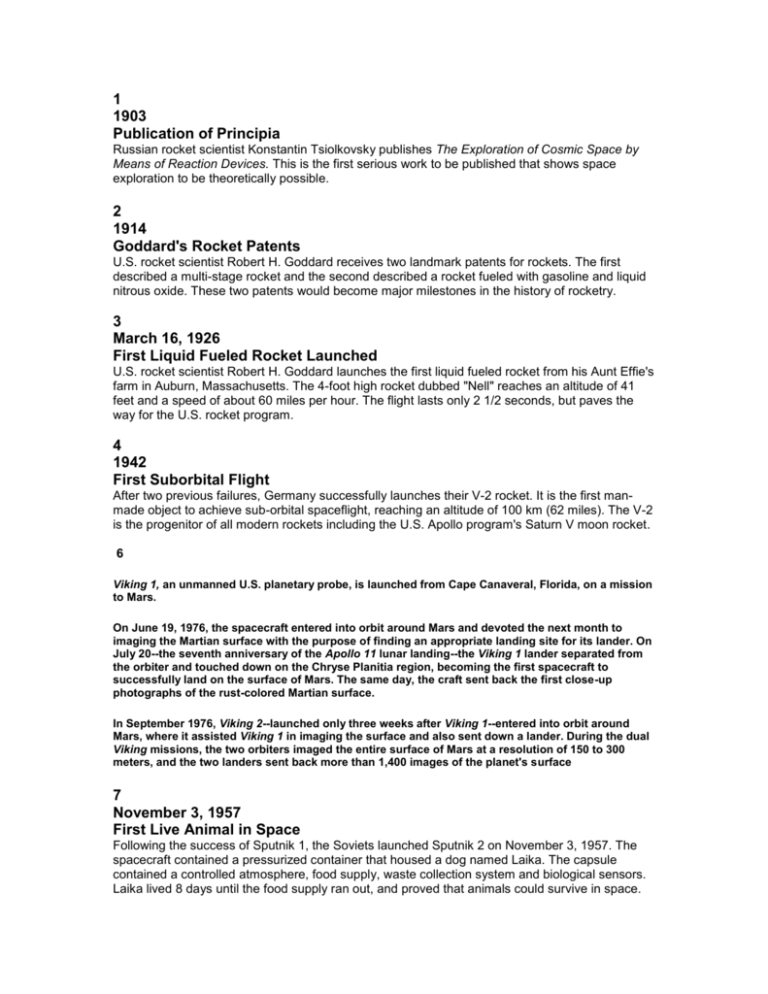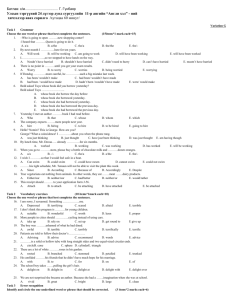1 - knomi.net
advertisement

1 1903 Publication of Principia Russian rocket scientist Konstantin Tsiolkovsky publishes The Exploration of Cosmic Space by Means of Reaction Devices. This is the first serious work to be published that shows space exploration to be theoretically possible. 2 1914 Goddard's Rocket Patents U.S. rocket scientist Robert H. Goddard receives two landmark patents for rockets. The first described a multi-stage rocket and the second described a rocket fueled with gasoline and liquid nitrous oxide. These two patents would become major milestones in the history of rocketry. 3 March 16, 1926 First Liquid Fueled Rocket Launched U.S. rocket scientist Robert H. Goddard launches the first liquid fueled rocket from his Aunt Effie's farm in Auburn, Massachusetts. The 4-foot high rocket dubbed "Nell" reaches an altitude of 41 feet and a speed of about 60 miles per hour. The flight lasts only 2 1/2 seconds, but paves the way for the U.S. rocket program. 4 1942 First Suborbital Flight After two previous failures, Germany successfully launches their V-2 rocket. It is the first manmade object to achieve sub-orbital spaceflight, reaching an altitude of 100 km (62 miles). The V-2 is the progenitor of all modern rockets including the U.S. Apollo program's Saturn V moon rocket. 6 Viking 1, an unmanned U.S. planetary probe, is launched from Cape Canaveral, Florida, on a mission to Mars. On June 19, 1976, the spacecraft entered into orbit around Mars and devoted the next month to imaging the Martian surface with the purpose of finding an appropriate landing site for its lander. On July 20--the seventh anniversary of the Apollo 11 lunar landing--the Viking 1 lander separated from the orbiter and touched down on the Chryse Planitia region, becoming the first spacecraft to successfully land on the surface of Mars. The same day, the craft sent back the first close-up photographs of the rust-colored Martian surface. In September 1976, Viking 2--launched only three weeks after Viking 1--entered into orbit around Mars, where it assisted Viking 1 in imaging the surface and also sent down a lander. During the dual Viking missions, the two orbiters imaged the entire surface of Mars at a resolution of 150 to 300 meters, and the two landers sent back more than 1,400 images of the planet's surface 7 November 3, 1957 First Live Animal in Space Following the success of Sputnik 1, the Soviets launched Sputnik 2 on November 3, 1957. The spacecraft contained a pressurized container that housed a dog named Laika. The capsule contained a controlled atmosphere, food supply, waste collection system and biological sensors. Laika lived 8 days until the food supply ran out, and proved that animals could survive in space. 11 July 20, 1969 First Manned Moon Landing Apollo 11 makes the first successful soft landing on the Moon. Neil Armstrong and Edwin Aldrin, Jr. become the first human beings to set foot on another world. 12 April 19, 1971 First Space Station The Salyut 1 space station is launched by the U.S.S.R. It remains in orbit until May 28, 1973. 13 November 13, 1971 First Spacecraft to Orbit Another Planet American space probe Mariner 9 (launched May 30, 1971) is the first spacecraft to orbit another planet, Mars. Over the next year, it maps 100 percent of the Martian surface. 15 May 14, 1973 First U.S. Space Station The United States launches Skylab, the first U.S. space station. It will be occupied by three crews and be an important arena for a number of scientific experiments. 16 May 14, 1973 First U.S. Space Station The United States launches Skylab, the first U.S. space station. It will be occupied by three crews and be an important arena for a number of scientific experiments. 17 July 20, 1976 First Surface Images of Mars The first pictures of the surface of Mars are sent back to Earth by Viking 1, the first U.S. spacecraft to successfully land a on another planet. 19 April 12, 1981 First Space Shuttle Launch The first manned mission of the Space Transportation System (STS-1), Columbia, is launched. This mission, as well as the next three, will be a test flight to try out the spacecraft's systems. 20 February 20, 1986 Mir Station Launched The first phase of the Mir space station is successfully launched and placed into Earth orbit. 21 April 24, 1990 Launch of Hubble Space Telescope Space Shuttle Discovery lifts off for mission STS-31, carrying the Edwin P. Hubble Space Telescope (HST). The telescope is successfully deployed, but is found to contain a seriously flawed primary mirror resulting in fuzzy images. 22 July 4, 1997 Mars Pathfinder Lands on Mars The Mars Pathfinder probe lands on the surface of Mars. A small robotic rover examines the nearby terrain, sending back amazing images of the planet's surface. 23 December 4, 1998 First American ISS Module The Space Shuttle Endeavour lifts off for space carrying the Unity module for the International Space Station (ISS). The unity module is attached to the Russian Zarya module, which was launched in November.











